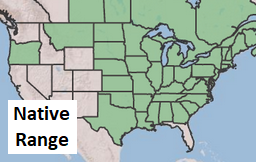Common Milkweed
Asclepias syriaca
Click here to download a PDF of this plant information page (for printing).

Sun Exposure: Sun, Part Sun
Season of Interest: Summer, Fall
Bloom Time: June - August
Bloom Color: Pink to Lavender
Height: 36 to 48 in.
Spread: 8 to 12 in.
Spacing: 15 in.
Water Needs: Average
Maintenance: Very little
Soil Type: Clay, Loam, Sandy Rocky
Soil pH: Acidic, Neutral
Soil Drainage: Well drained
Pests: Aphids
Diseases: None
Wildlife: Bees, Buterflies

Description:
Common milkweed is a native herbaceous perennial that appeals to butterflies—especially the monarch butterfly. Asclepias is the only plant family that serves as the host plant for monarch butterfly egg laying. The monarch larvae, the hatchling caterpillars, feed exclusively on milkweed leaves. Without milkweed, there can be no monarch butterflies.
Common milkweed grows quickly to two to four feet in height. It has a narrow vertical growth habit and thick, long, oblong green leaves that grow to about eight inches. Once established, milkweed spreads rapidly by self-seeding if seed pods are not removed. In late spring to midsummer, fragrant clusters of pink-purple flowers appear. The leaves of milkweed and the milk-like substance within are toxic, except for monarch butterflies. Milkweed is not only toxic to humans and pets but also to cows and other livestock. For more information see:
plants.ces.ncsu.edu/plants/asclepias-syriaca
Care and Growing Tips:
Common milkweed prefers full sunlight. It grows best in an open area where there are six to eight hours of sunlight per day. This plant tolerates dry conditions, infertile soil, and rocky conditions. It thrives in soil with a pH range of 4.8 to 7.2. Common milkweed does not need watering except in the driest conditions. Water deeply, giving the plants between one to two inches of water, then wait until the top inch of soil is dry before watering again. Overwatering common milkweed can result in a variety of fungal diseases. It also tolerates a wide range of temperatures and humidity. But because it is native to eastern parts of the United States, it will not do well in extreme and extended heat or humidity. The plant goes dormant in the winter. There's no need to fertilize common milkweed plants.